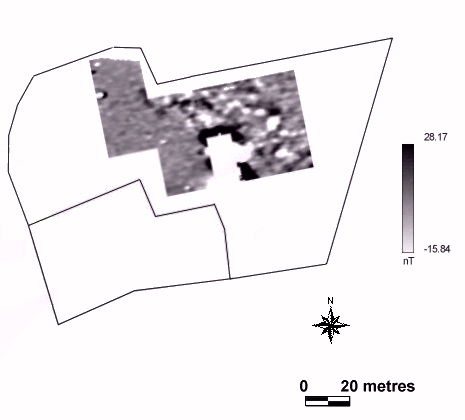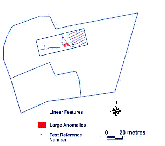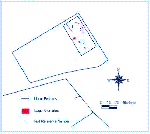
Fig. 6.5 Magnetometer survey, fields 155 and 156 (Site 2/22)
Fig. 6.6 Interpretative plan of magnetometer survey, fields 155 and 156 (Site 2/22)
(javascript must be enabled to view overlaying images)
These fields were surveyed, using resistivity and magnetometric techniques, on the site of a medieval chapel. These fields also coincided with a concentration of Roman pottery and tile. Maize crops to the east prevented all of the area from being surveyed.

Fig. 6.5 Magnetometer survey, fields 155 and 156 (Site 2/22)
Fig. 6.6 Interpretative plan of magnetometer survey, fields 155 and 156 (Site 2/22)
(javascript must be enabled to view overlaying images)
Results of the magnetometer survey revealed a number of potential rectilinear anomalies (Figs 6.5 - 6.6). In particular, two were prominent [1, 2], in close proximity to a linear feature across the centre of the survey [3]. On the east side of the area, several discrete negative anomalies marked what may be pits, or possibly graves or sarcophagi from the burial grounds associated with the chapel [4] (cf. the stone coffin located nearby, Fig. 5.1). A further linear feature running parallel to the rectilinear features, and approximately perpendicular to it, was noted in the south-eastern corner of the survey [5], running at a slight angle to a series of negative readings further to the north [6]. These lines enclose a large negative anomaly [7], probably a burial similar to the negative features to the north [4].


Fig. 6.7. Resistivity survey, fields 155 and 156 (Site 2/22) &
Fig. 6.8 Interpretative plan of resistivity survey, fields 155 and 156 (Site 2/22)
Resistivity survey results, carried out on a substantially smaller portion of the survey area, appeared to show little correlation with the magnetometer results (Fig. 6.7). Once more, broad trends and changes in resistance of the soil were most prominent (Fig. 6.8), although a change in resistance across the survey area appears to correspond with the linear anomaly represented in the magnetometer results [1]. A series of linear features to the east of the boundary were noticeable, probably the result of differences in the resistance encountered in the soil from plough furrows [2]. A rectilinear feature was visible to the west of [1], possibly associated with a similar anomaly represented in the magnetometer survey [3]. To the west, a long linear anomaly was noted [4].
Both magnetometer and resistivity surveys of this field were limited in size, and in the quality of data which were recorded (Figs 6.9 - 6.10). As contact problems for the resistivity produced a wide range of readings and no obvious features appeared, no plans have been included here. A slight linear anomaly could be located on the magnetometer survey [1], together with a curvilinear feature to the east [2] and a number of discrete positive entities to the south [3].


Fig. 6.9. Magnetometer survey, field 254 (Site 2/27) &
Fig. 6.10 Interpretative plan of magnetometer survey, field 254 (Site 2/27)
© Internet Archaeology
URL: http://intarch.ac.uk/journal/issue9/millett/geophys2.html
Last updated: Sat Dec 30 2000